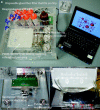Applications of microfluidics for molecular diagnostics
- PMID: 23329451
- PMCID: PMC7121806
- DOI: 10.1007/978-1-62703-134-9_20
Applications of microfluidics for molecular diagnostics
Abstract
Diagnostic assays implemented in microfluidic devices have developed rapidly over the past decade and are expected to become commonplace in the next few years. Hundreds of microfluidics-based approaches towards clinical diagnostics and pathogen detection have been reported with a general theme of rapid and customizable assays that are potentially cost-effective. This chapter reviews microfluidics in molecular diagnostics based on application areas with a concise review of microfluidics in general. Basic principles of microfabrication are briefly reviewed and the transition to polymer fabricated devices is discussed. Most current microfluidic diagnostic devices are designed to target a single disease, such as a given cancer or a variety of pathogens, and there will likely be a large market for these focused devices; however, the future of molecular diagnostics lies in highly multiplexed microfluidic devices that can screen for potentially hundreds of diseases simultaneously.
Figures


References
-
- UNAIDS (2010) UNAIDS Report on the global AIDS epidemic, UNAIDS.
-
- Foster RS, Heffler SK. Updated and Extended National Health Expenditure Projections, 2010–2019, Office of the Actuary. Maryland: Centers for Medicare & Medicaid Services; 2009.
Publication types
MeSH terms
Substances
LinkOut - more resources
Full Text Sources
Miscellaneous

